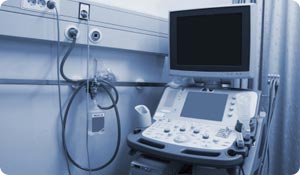
Ultrasound is an effective and relatively inexpensive way to detect inflammation before joint damage occurs and can be detected on X-rays. However, a recent study questioned whether this imaging test can predict how arthritis will progress when you have rheumatoid arthritis.
A team of researchers from St George's Healthcare Trust in London conducted a study of 40 patients with rheumatoid arthritis. At the beginning of the study the researchers obtained ultrasound measures of bone damage and synovial disease, including grayscale and power Doppler (PD) scores from one joint per patient in each patient. Ultrasound damage was graded between 0 and 3 where 0 was absence of disease and 3 indicated marked damage.
After a minimum of two years, the same joints were scanned to obtain a new erosion score. The ultrasound tests showed that bone damage had occurred in 12 of the 25 joints, including four of the eight patients treated with anti-tumor necrosis factor therapy.
Also, analysis showed that erosion scores taken at the beginning of the study were significantly higher in joints that did not show progressive bone damage in the entire study group, as well as in the 14 patients who received disease-modifying anti-rheumatic drugs (DMARDs) compared with those who did not.
The researchers didn't find any other significant difference between ultrasound and blood serologic (blood serum) scores between joints that developed progressive damage and those that did not.
The findings contradict an earlier study that found ultrasound was valuable in the early detection of rheumatoid arthritis progression. However, researchers in the current study suggest that the difference may be a result of how the ultrasound test is conducted. How long participants had rheumatoid arthritis may also affect the outcome.
A More Reliable Tool to Predict the Progress of Rheumatoid Arthritis?
People with rheumatoid arthritis have disease-specific autoantibodies called anti-citrullinated protein/ peptide antibodies in their blood. The anti-CCP (anti-cyclic citrullinated peptide) antibody test helps to detect these disease markers and diagnose RA in the early stages. It's considered more sensitive than the test for rheumatoid factor, another marker of RA.
A 2004 study found that the anti-CPP antibody test can also help to predict how rheumatoid arthritis will progress. The Swedish researchers followed a group of 242 patients from onset of the disease for up to three years. They found that anti-CCP antibody results correlated with rheumatoid factor (RF, another blood marker of the disease), but were better than RF at predicting the course of the disease.
A British study also demonstrated the superiority of the anti-CCP2 test—the second generation test—over other blood tests. In people who were RF-negative, for instance, having an anti-CCP antibody value greater than 100 predicted poor function at 24 months.
For better monitoring and management of your disease, ask your rheumatologist about having the anti-CCP test or the newer anti-CCP2 test as soon as possible after diagnosis.
Study References
Journal Name: Skeletal Radiology, Vol. 38(5), pp. 473-8
Study Date: May 2009
Study Name: Prediction of erosion progression using ultrasound in established rheumatoid arthritis: a 2-year follow-up study.
Website: http://www.ncbi.nlm.nih.gov/pubmed/19259659
Authors: Reynolds PP, Heron C, Pilcher J, Kiely PD.
Journal Name: Annals of the Rheumatic Diseases, Vol. 63, pp.1085-1089
Study Date: 2004
Study Name: Anti-CCP antibody test predicts the disease course during 3 years in early rheumatoid arthritis (the Swedish TIRA project)
Website: http://ard.bmj.com/cgi/content/abstract/63/9/1085
Authors: A Kastbom, G Strandberg, A Lindroos and T Skogh
Journal Name: Rheumatology, Vol. 45(4):478-480
Study Date: 2006
Study Name: Anti-CCP antibodies measured at disease onset help identify seronegative rheumatoid arthritis and predict radiological and functional outcome
Website: http://rheumatology.oxfordjournals.org/cgi/content/full/45/4/478
Authors: M. A. Quinn, A. K. S. Gough, M. J. Green, J. Devlin, E. M. A. Hensor, A. Greenstein, A. Fraser and P. Emery





